Charles E W Bean, Diaries, AWM38 3DRL 606/248/1 - 1917 - 1931 - Part 1
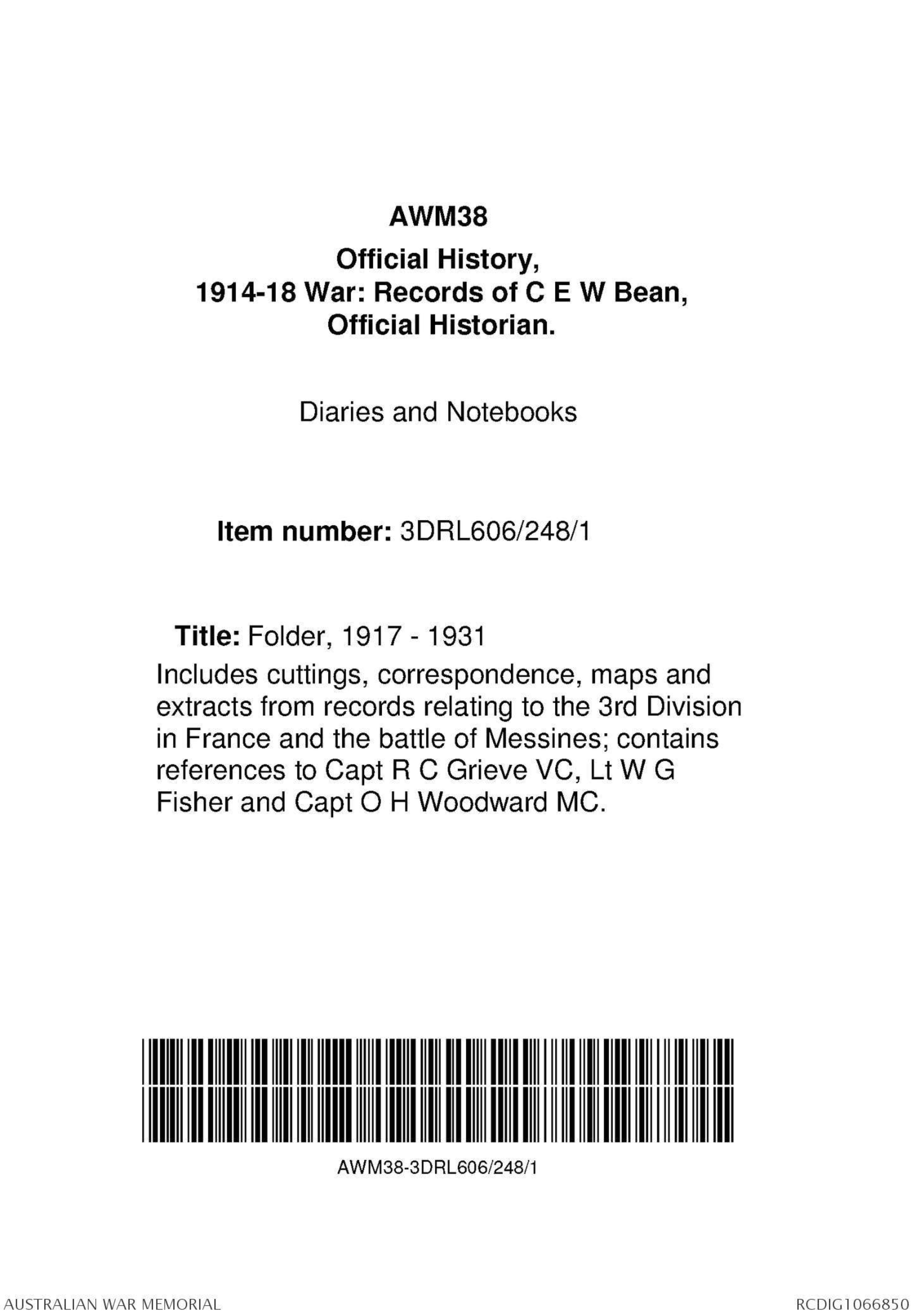
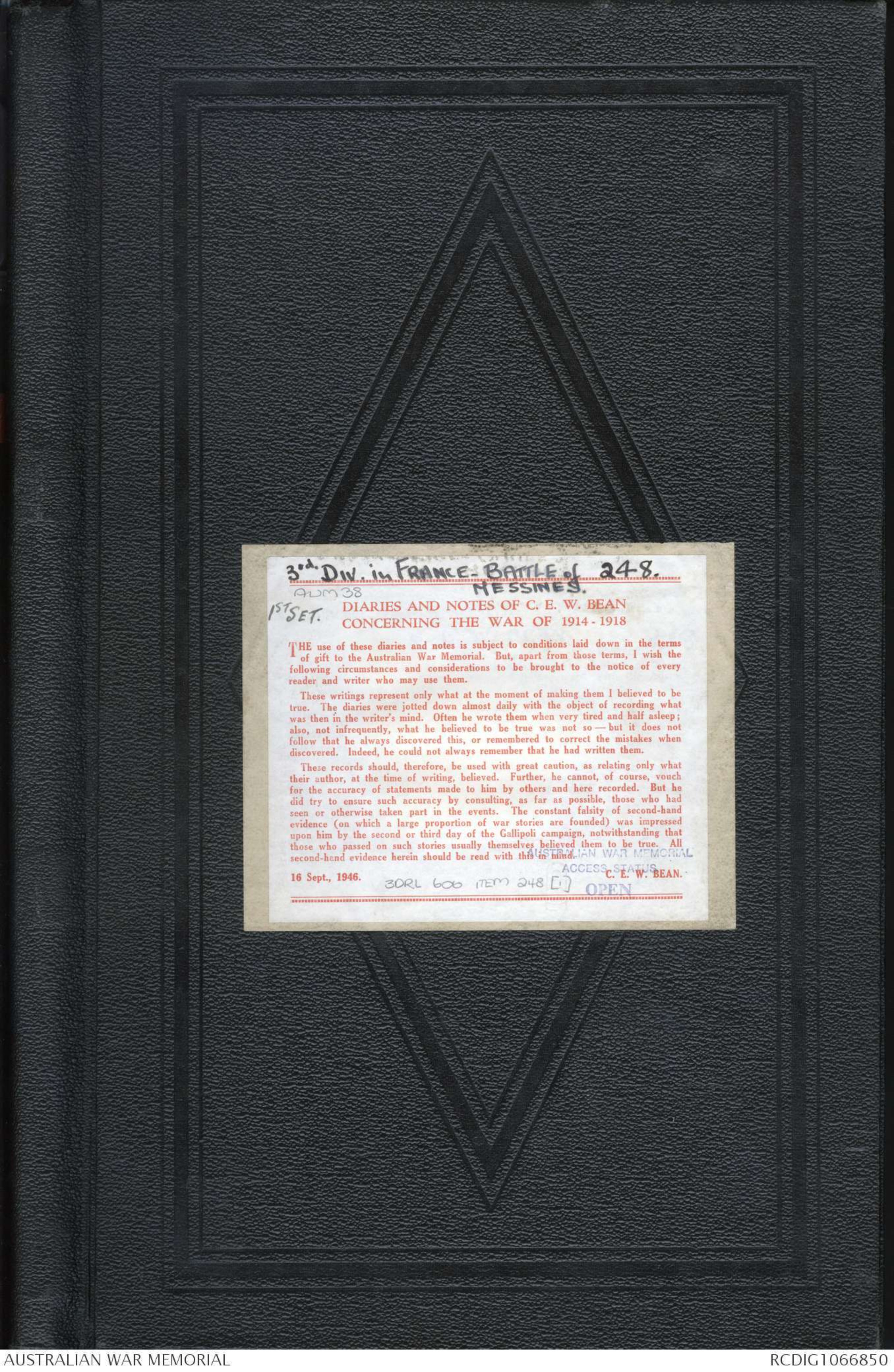
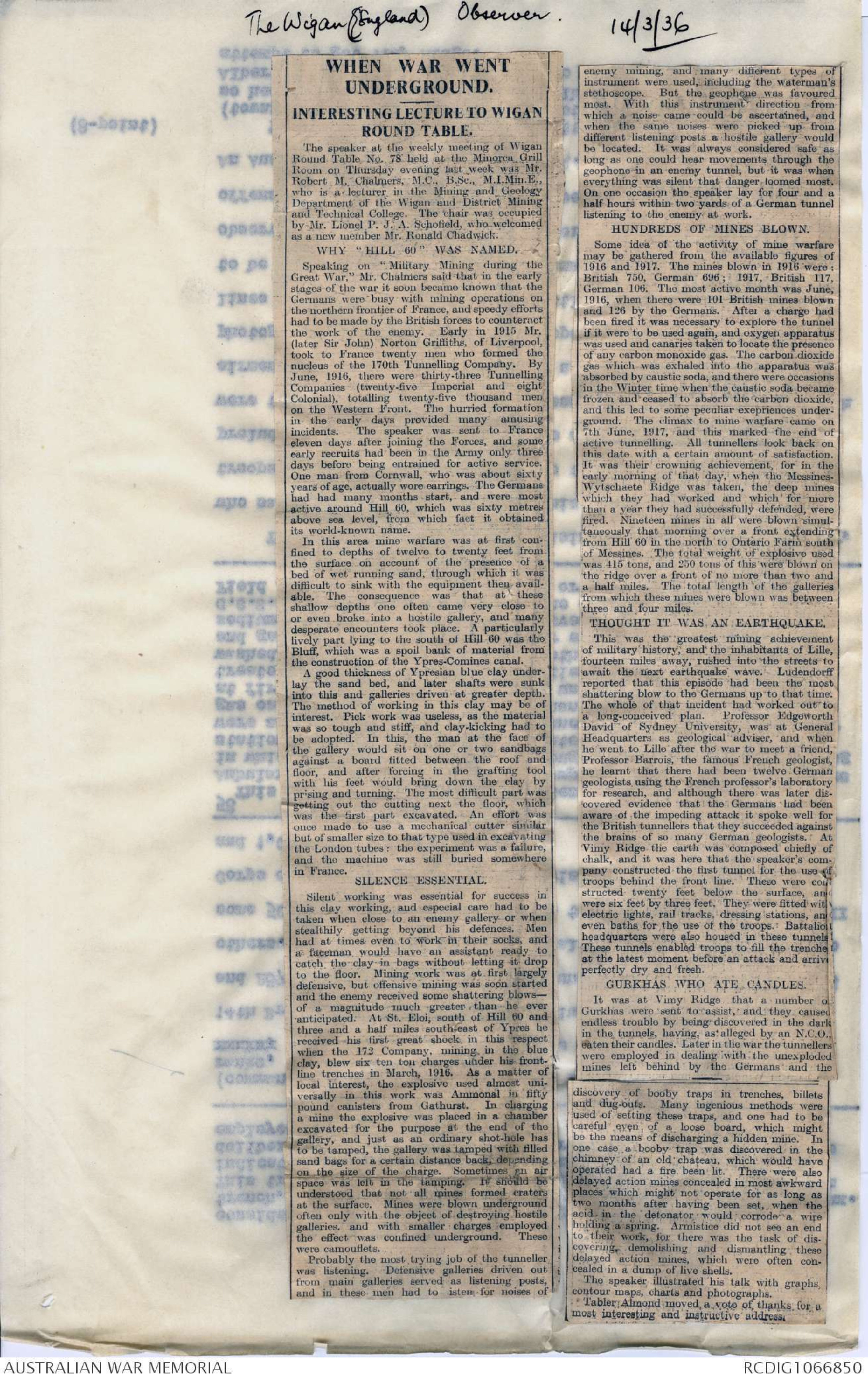
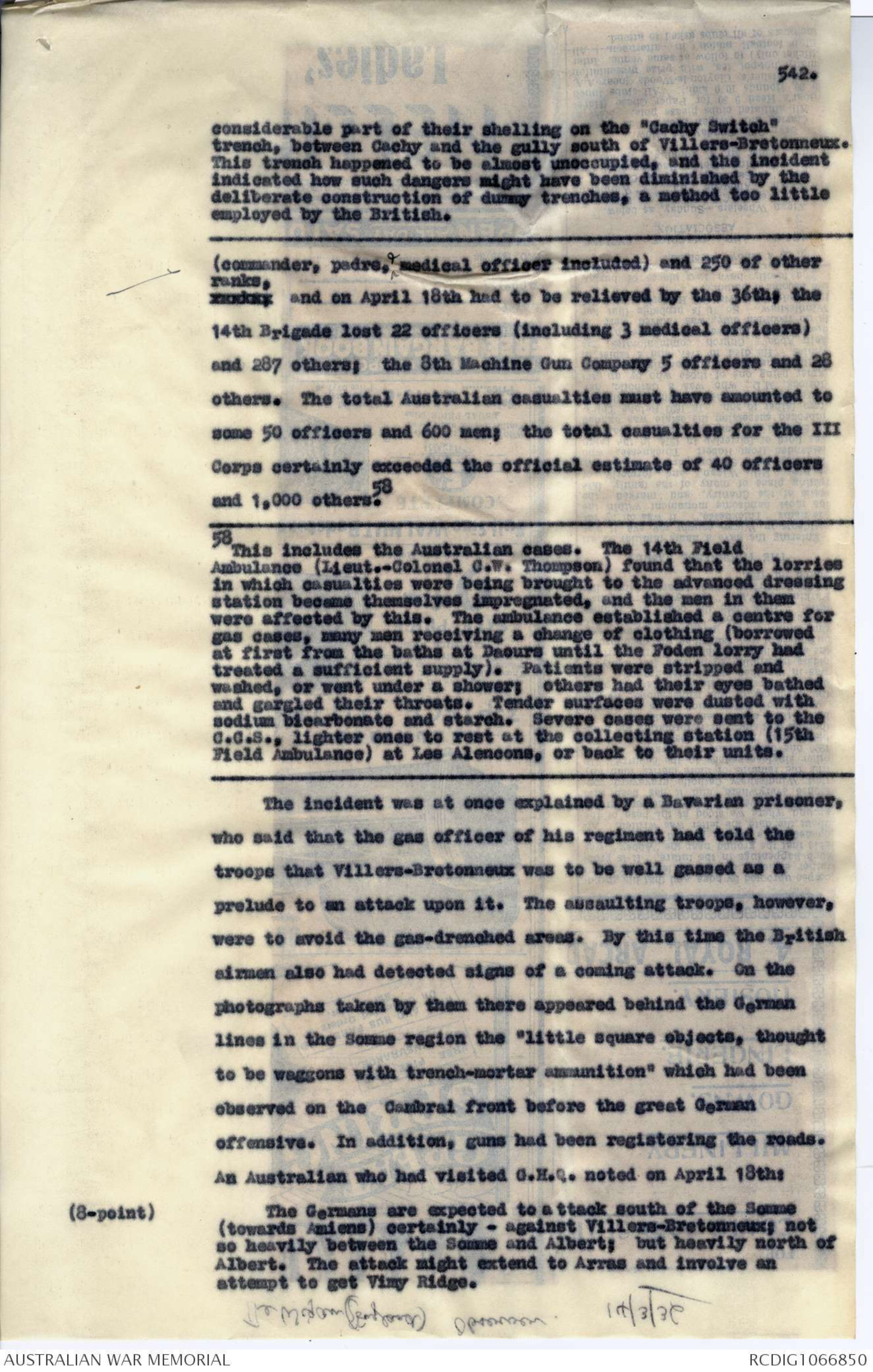

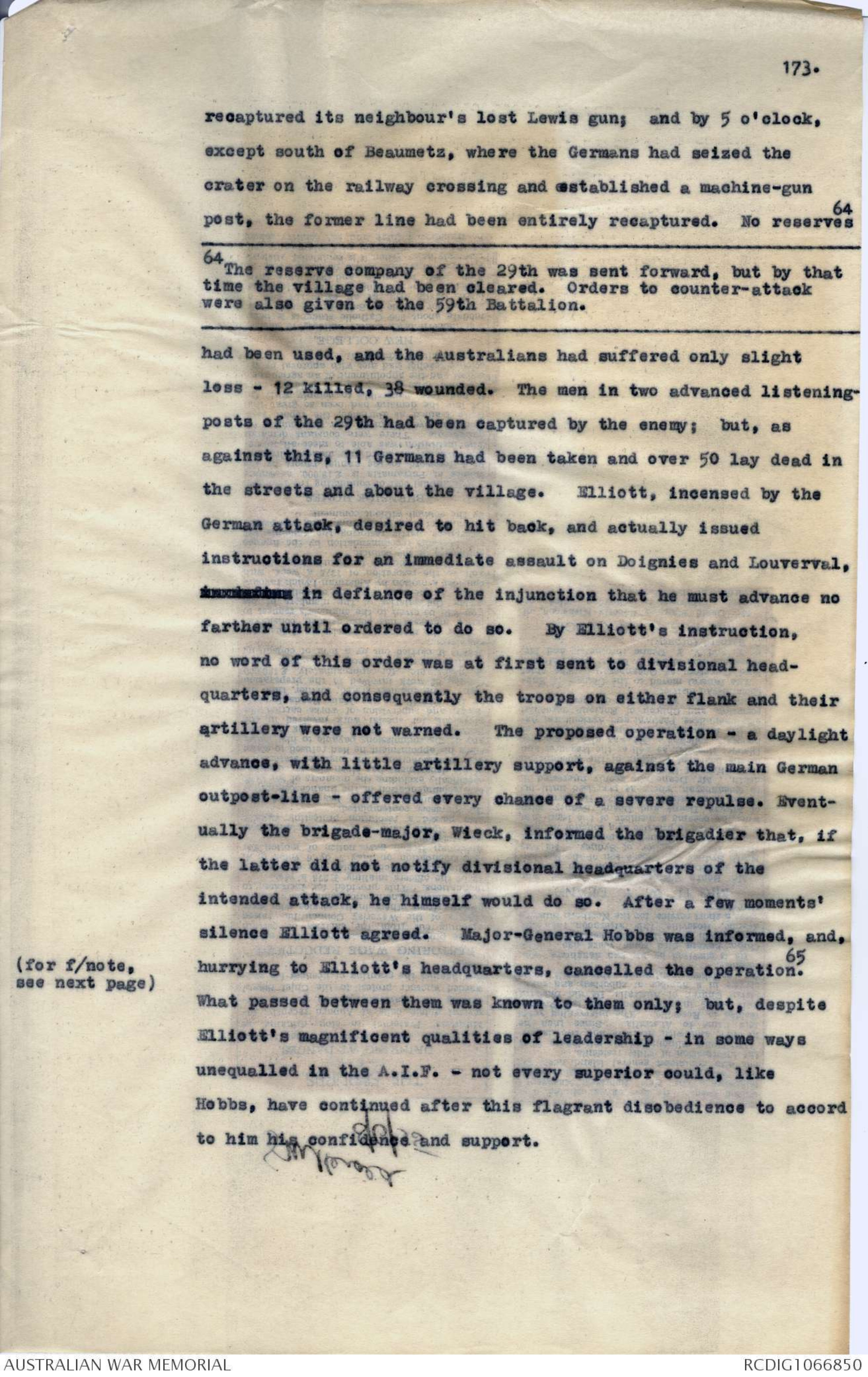
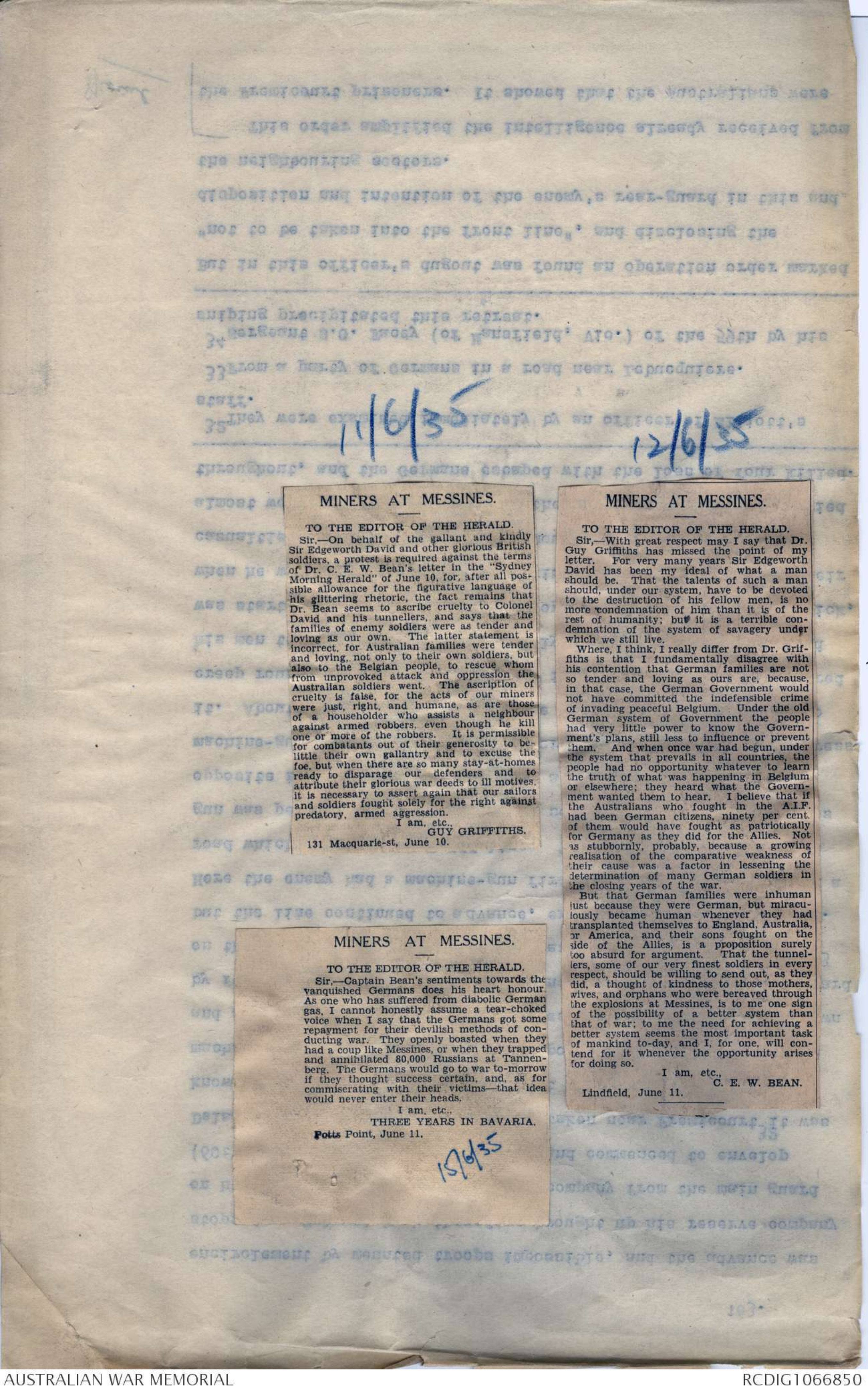
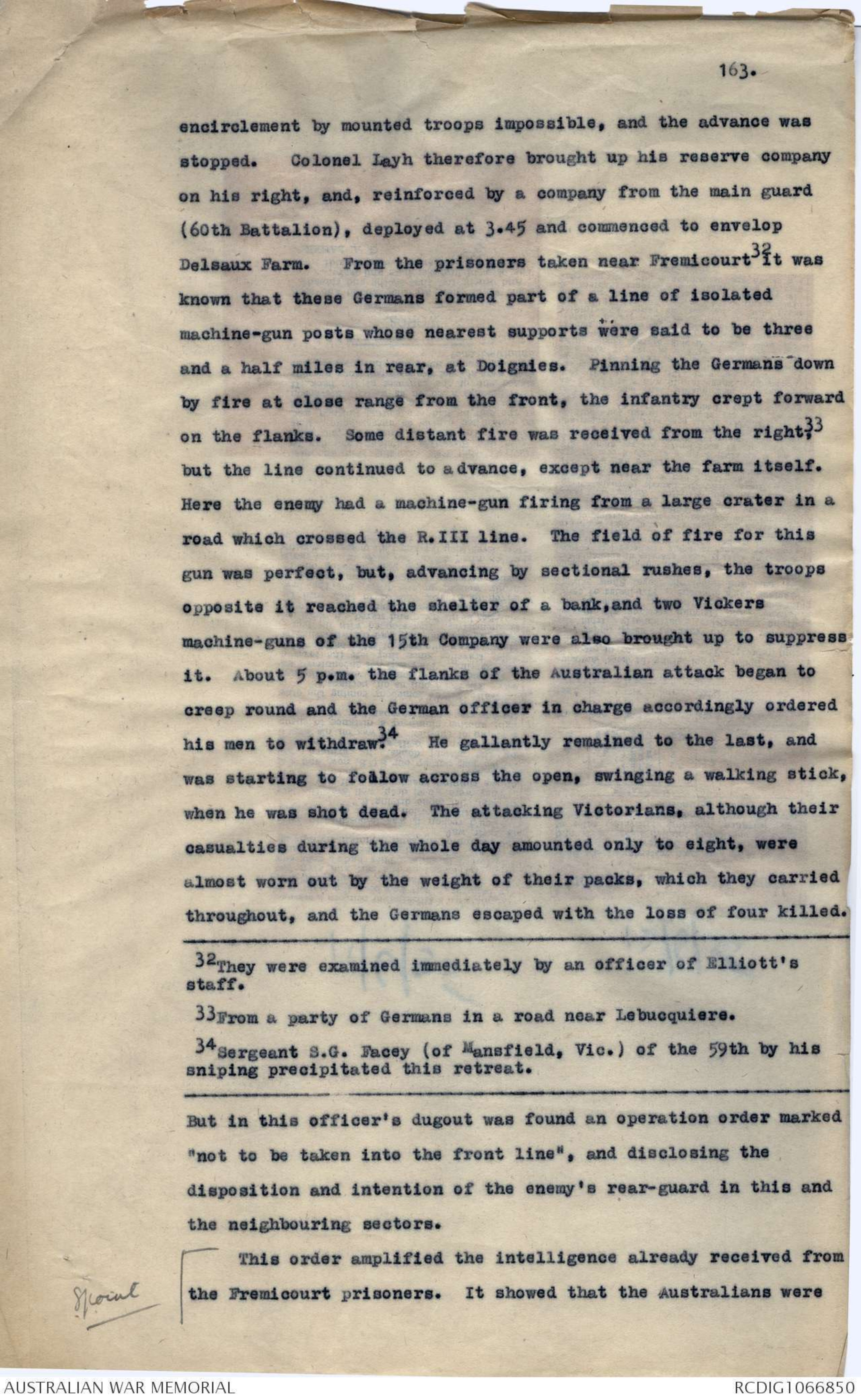
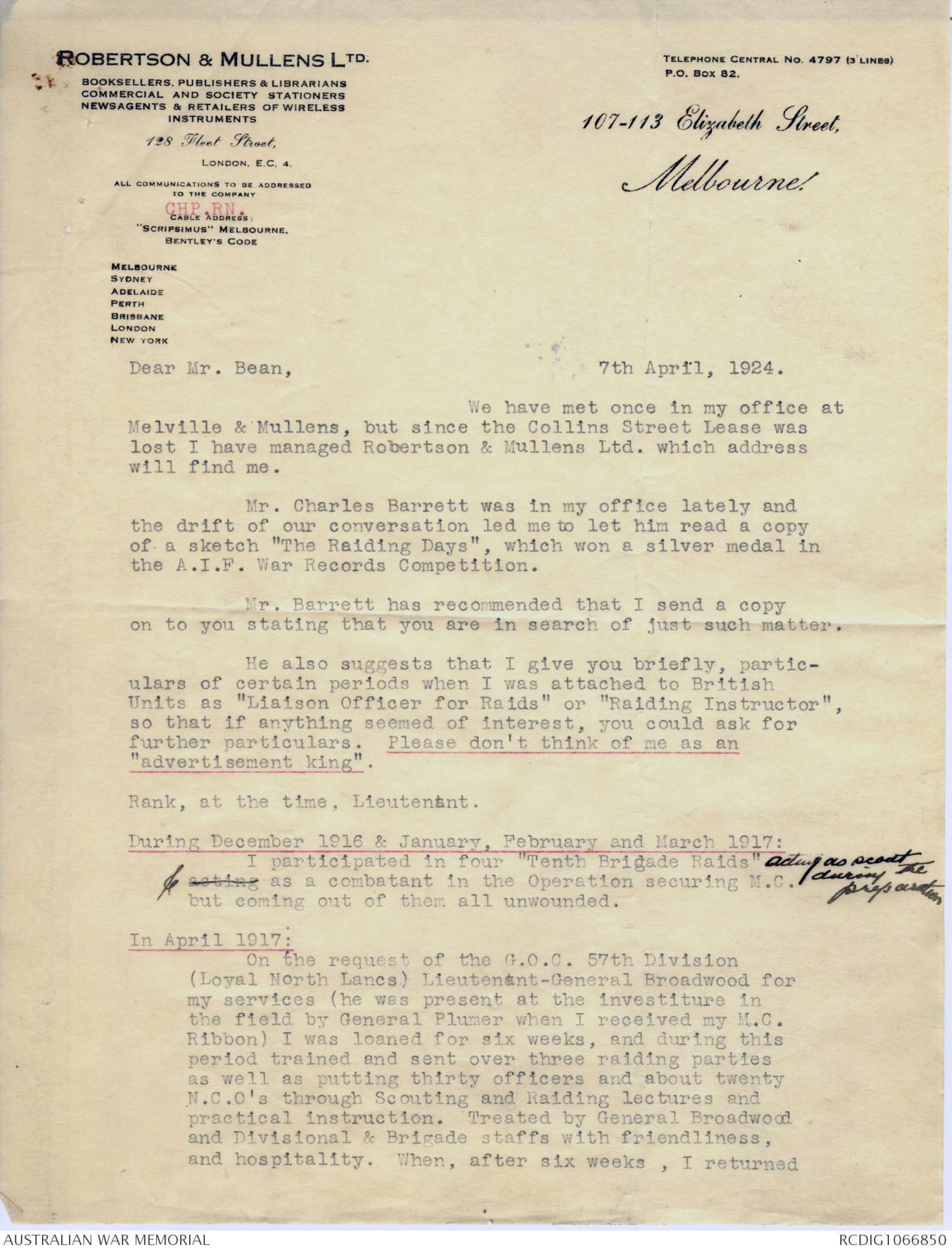
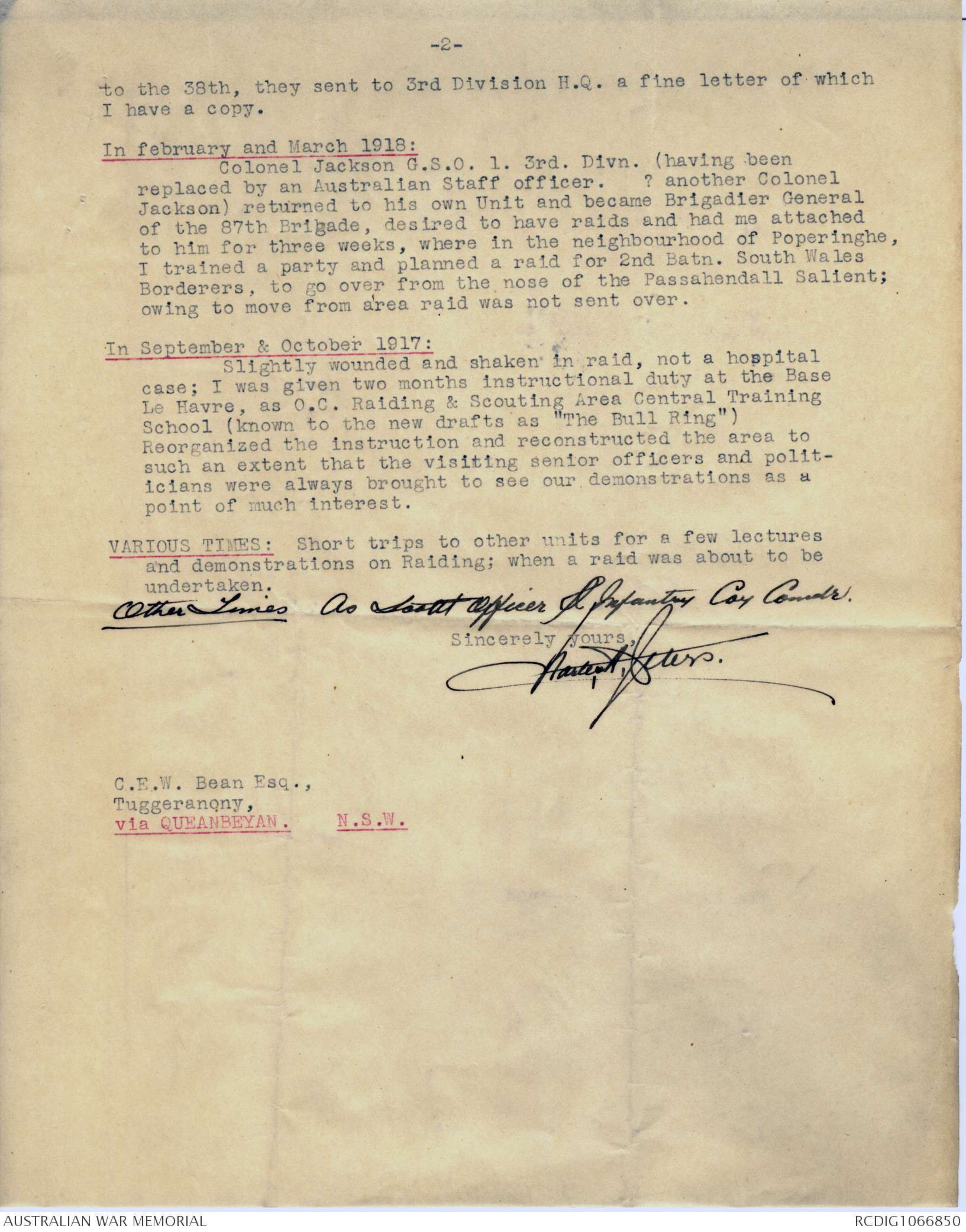
AWM38
Official History,
1914-18 War: Records of C E W Bean,
Official Historian.
Diaries and Notebooks
Item number: 3DRL606/248/1
Title: Folder, 1917 - 1931
Includes cuttings, correspondence, maps and
extracts from records relating to the 3rd Division
in France and the battle of Messines; contains
references to Capt R C Grieve VC, Lt W G
Fisher and Capt O H Woodward MC.
AWM38-3DRL606/248/1
3rd DIV, in FRANCE-BATTLE of MESSINES.
248
AWM38
1ST SET.
DIARIES AND NOTES OF C. E. W. BEAN
CONCERNING THE WAR OF 1914-1918
THE use of these diaries and notes is subject to conditions laid down in the terms
of gift to the Australian War Memorial. But, apart form those terms, I wish the
following circumstances and considerations to be brought to the notice of every
reader and writer who may use them.
These writings represent only what at the moment of making them I believed to be
true. The diaries were jotted down almost daily with the object of recording what
was then in the writer's mind. Often he wrote them when very tired and half asleep;
also, not infrequently, what he believed to be true was not so - but it does not
follow that he always discovered this, or remembered to correct the mistakes when
discovered. Indeed, he could not always remember that he had written them.
These records should, therefore, be used with great caution, as relating only what
their author, at the time of writing, believed. Further, he cannot, of course, vouch
for the accuracy of statements made to him by others and here recorded. But he
did try to ensure such accuracy by consulting, as far as possible, those who had
seen or otherwise taken part in the events. The constant falsity of second-hand
evidence (on which a large proportion of war stories are founded) was impressed
upon him by the second or third day of the Gallipoli campaign, notwithstanding that
those who passed on such stories usually themselves believed them to be true. All
second-hand evidence herein should be read with this in mind.
16 Sept., 1946.
C.E.W. BEAN.
AUSTRALIAN WAR MEMORIAL
ACCESS STATUS
OPEN
3DRL 606 ITEM 248[1]
The Wigan (England) Observer
14/3/36
WHEN WAR WENT
UNDERGROUND.
INTERESTING LECTURE TO WIGAN
ROUND TABLE.
The speaker at the weekly meeting of Wigan
Round Table No. 78 held at the Minorca Grill
Room on Thursday evening last week was Mr.
Robert M. Chalmers, M.C., B.Sc., M.I.Min.E.,
who is a lecturer in the Mining and Geology
Department of the Wigan and District Mining
and Technical College. The chair was occupied
by Mr. Lionel P.J.A. Schofield, who welcomed
as a new member Mr. Ronald Chadwick.
WHY "HILL 60" WAS NAMED.
Speaking on "Military Mining during the
Great War," Mr. Chalmers said that in the early
stages of the war it soon became known that the
Germans were busy with mining operations on
the northern frontier of France, and speedy efforts
had to be made by the British forces to counteract
the work of the enemy. Early in 1915 Mr.
(later Sir John) Norton Griffiths, of Liverpool,
took to France twenty men who formed the
nucleus of the 170th Tunnelling Company. By
June, 1916, there were thirty-three Tunnelling
Companies (twenty-five Imperial and eight
Colonial), totalling twenty-five thousand men
on the Western Front. The hurried formation
in the early days provided many amusing
incidents. The speaker was sent to France
eleven days after joining the Forces, and some
early recruits had been in the Army only three
days before being entrained for active service.
One man from Cornwall, who was about sixty
years of age, actually wore earrings. The Germans
had had many months start, and were most
active around Hill 60, which was sixty metres
above sea level, from which fact it obtained
its world-known name.
In this area mine warfare was at first confined
to depths of twelve to twenty feet from
the surface on account of the presence of a
bed of wet running sand, through which it was
difficult to sink with the equipment then available.
The consequences was that at these
shallow depths one often came very close to
or even broke into a hostile gallery, and many
desperate encounters took place. A particularly
lively part lying to the south of Hill 60 was the
Bluff, which was a spoil bank of material from
the construction of the Ypres-Comines canal.
A good thickness of Ypresian blue clay underlay
the sand bed, and later shafts were sunk
into this and galleries driven at greater depth.
The method of working in this clay may be of
interest. Pick work was useless, as the material
was so tough and stiff, and clay-kicking had to
be adopted. In this, the man at the face of
the gallery would sit on one or two sandbags
against a board fitted between the roof and
floor, and after forcing in the grafting tool
with his feet would bring down the clay by
prising and turning. The most difficult part was
getting out the cutting next the floor, which
was the first part excavated. An effort was
once made to use a mechanical cutter similar
but of smaller size to that type used in excavating
the London tubes: the experiment was a failure,
and the machine was still buried somewhere
in France.
SILENCE ESSENTIAL.
Silent working was essential for success in
this clay working, and especial care had to be
taken when close to an enemy gallery or when
stealthily getting beyond his defences. Men
had at times even to work in their socks, and
a faceman would have an assistant ready to
catch the clay in bags without letting it drop
to the floor. Mining work was at first largely
defensive, but offensive mining was soon started
and the enemy received some shattering blows -
of a magnitude much greater than he ever
anticipated. At St. Eloi, south of Hill 60 and
three and a half miles south-east of Ypres he
received his first great shock in this respect
when the 172 Company, mining in the blue
Clay, blew six ten ton charges under his frontline
trenches in Mach, 1916. As a matter of
local interest, the explosive used almost universally
in this work was Ammonal in fifty
pound canisters from Gathurst. In charging
a mine the explosive was placed in a chamber
excavated for the purpose at the end of the
gallery, and just as an ordinary shot-hole has
to be tamped, the gallery was tamped with filled
sand bags for a certain distance back, depending
on the size of charge. Sometimes an air
space was left in the tamping. It should be
understood that not all mines formed craters
at the surface. Mines were blown underground
often only with the object of destroying hostile
galleries, and with smaller charges employed
the effect was confined underground. These
were camouflets.
Probably the most trying job of the tunneller
was listening. Defensive galleries driven out
from main galleries served as listening posts,
and in these men had to listen for noises of
enemy mining, and many different types of
instrument were used, including the waterman's
stethoscope. But the geophone was favoured
most. With this instrument direction from
which a noise came could be ascertained, and
when the same noises were picked up from
different listening posts a hostile gallery would
be located. It was always considered sage as
long as one could hear movements through the
geophone in an enemy tunnel, but it was when
everything was silent that danger loomed most.
On one occasion, the speaker lay for four and a
half hours within two yards of a German tunnel
listening to the enemy at work.
HUNDREDS OF MINES BLOWN.
Some idea of the activity of mine warfare
may be gathered from the available figures of
1916 and 1917. The mines blow in 1916 were:
British 750, German 696; 1917, British 117,
German 106. The most active month was June,
1916, when there were 101 British mines blown
and 126 by the Germans. After a charge had
been fired it was necessary to explore the tunnel
if it were to be used again, and oxygen apparatus
was used and canaries taken to locate the presence
of any carbon monoxide gas. The carbon dioxide
gas which was exhaled into the apparatus was
absorbed by caustic soda, and there were occasions
in the Winter time when the caustic soda became
frozen and ceased to absorb the carbon dioxide,
and this led to some peculiar exepriences underground.
The climax to mine warfare came on
7th June, 1917, and this marked the end of
active tunnelling. All tunnellers look back on
this date with a certain amount of satisfaction.
It was their crowning achievement, for in the
early morning of that day, when the Messines-Wytschaete
Ridge was taken, the deep mines
which they had worked and which for more
than a year they had successfully defended, were
fired. Nineteen mines in all were blown simultaneously
that morning over a front extending
from Hill 60 in the north to Ontario Farm south
of Messines. The total weight of explosive used
was 415 tons, and 250 tons of this were blown on
the ridge over a front of no more than two and
a half miles. The total length of the galleries
from which these mines were blown was between
three and four miles.
THOUGHT IT WAS AN EARTHQUAKE.
This was the greatest mining achievement
of military history, and the inhabitants of Lille,
fourteen miles away, rushed into the streets to
await the next earthquake wave. Ludendorff
reported that this episode had been the most
shattering blow to the Germans up to that time.
The whole of that incident had worked out to
a long-conceived plan. Professor Edgeworth
David of Sydney University, was at General
Headquarters as geological adviser, and when
he went to Lille after the war to meet a friend,
Professor Barrois, the famous French geologist,
he learnt that there had been twelve German
geologists using the French professor's laboratory
for research, and although there was later discovered
evidence that the Germans had been
aware of the impending attack it spoke well for
the British tunnellers that they succeeded again
the brains of so many German geologists. At
Vimy Ridge the earth was composed chiefly of
chalk, and it was here that the speaker's company
constructed the first tunnel for the use of
troops behind the front line. These were constructed
twenty feet below the surface, and
were six feet by three feet. They were fitted with
electric lights, rail tracks, dressing stations, and
even baths for the use of the troops. Battalion
headquarters were also housed in these tunnels.
These tunnels enabled troops to fill the trenches
at the latest moment before an attack and arrive
perfectly dry and fresh.
GURKHAS WHO ATE CANDLES.
It was at Vimy Ridge that a number of
Gurkhas were sent to assist, and they caused
endless trouble by being discovered in the dark
in the tunnels, having, as alleged by an N.C.O.,
eaten their candles. Later in the war the tunnellers
were employed in dealing with the unexploded
mines left behind by the Germans and the
discovery of booby traps in trenches, billets
and dug-outs. Many ingenious methods were
used of setting these traps, and one had to be
careful even of a loose board, which might
be the means of discharging a hidden mine. In
one case a booby trap was discovered in the
chimney of an old chateau, which would have
operated had a fire been lit. There were also
delayed action mines concealed in most awkward
places which might not operate for as long as
two months after having been set, when the
acid in the detonator would corrode a wire
holding a spring. Armistice did not see an end
to their work, for there was the task of discovering,
demolishing and dismantling these
delayed action mines, which were often concealed
in a dump of live shells.
The speaker illustrated his talk with graphs,
contour maps, charts and photographs.
Tabler Almond moved a vote of thanks for a
most interesting and instructive address.
542.
considerable part of their shelling on the "Cachy Switch"
trench, between Cachy and the gully south of Villers-Bretonneux.
This trench happened to be almost unoccupied, and the incident
indicated how such dangers might have been diminished by the
deliberate construction of dummy trenches, a method too little
employed by the British.
(commander, padre, ^& medical officer included) and 250 of otherxxxxxx ranks, and on April 18th had to be relieved by the 36th, the
14th Brigade lost 22 officers (including 3 medical officers)
and 287 others; the 8th Machine Gun Company 5 officers and 28
others. The total Australian casualties must have amounted to
some 50 officers and 600 men; the total casualties for the III
Corps certainly exceeded the official estimate of 40 officers
and 1,000 others. 58
58 This includes the Australian cases. The 14th Field
ambulance (Lieut.-Colonel C.W. Thompson) found that the lorries
in which casualties were being brought to the advanced dressing
station became themselves impregnated, and the men in them
were affected by this. The ambulance established a centre for
gas cases, many men receiving a change of clothing (borrowed
at first from the baths at Daours until the Foden lorry had
treated a sufficient supply). Patients were stripped and
washed, or went under a shower; others had their eyes bathed
and gargled their throats. Tender surfaces were dusted with
sodium bicarbonate and starch. Severe cases were sent to the
C.C.S., lighter ones to rest at the collection station (15th
Field Ambulance) at Les Alencons, or back to their units.
The incident was at once explained by a Bavarian prisoner,
who said that the gas officer of his regiment had told the
troops that Villers-Bretonneux was to be well gassed as a
prelude to an attack upon it. The assaulting troops, however,
were to avoid the gas-drenched areas. By this time the British
airmen also had detected signs of a coming attack. On the
photographs taken by them there appeared behind the German
lines in the Somme region the "little square objects, thought
to be waggons with trench-mortar ammunition" which had been
observed on the Cambrai front before the great German
offensive. In addition, guns had been registering the roads.
An Australian who had visited G.H.Q. noted on April 18th:
[*(8-point)*] The Germans are expected to a ttack south of the Somme
(towards Amiens) certainly - against Villers-Bretonneux; not
so heavily between the Somme and Albert; but heavily north of
Albert. The attack might extend to Arras and involve an
attempt to get Vimy Ridge.
[*SM Herald*]
[*8/6/35*]
HILL 60.
Epic of War Recalled.
OLD COMRADES' REUNION.
The triumph of the allied tunnelling companies
during a critical period of the war was
the keynote of the speeches delivered at the
annual reunion of the Tunnellers' Old Comrades'
Association at the Imperial Service
Club, Barrack-street, last night, So that many
who had participated in the work at Messines
might in some way associate themselves with
the function the speeches were broadcast.
Major Shand, the Government whip, who
was a Quartermaster in France, presided.
In proposing the toast of "Fallen Comrades"
he said they were celebrating that memorable
event in which skill, patience, courage, and
endurance achieved its object on the eventful
morning of June 7, 1917, when Captain Oliver
Woodward pressed the button and exploded the
mines under the famed Hill 60 on the western
front. That crowning event added lustre to the
records of the brave and indomitable men of
the Australian Imperial Forces.
"We recall the past," he said "and bring into
this wide circle of comradeship the memories
of those who answered the call and passed the
torch to us to carry on. Since out last reunion
our memories are turned to him who
was our guide, philosopher, and friend. I refer
to Professor Sir Edgeworth David, who when
the call of Empire sounded - and at an age far
beyond the meridian of life - stepped forward
and shared with us those days of peril, anxiety
and difficulty. He has left in our hearts the
remembrance of one whose nobility of character
and love for his fellow man will remain with
us till our travelling days are over."
A GREAT LEADER
Dr. C. E. W. Bean also paid a tribute to the
great leader who had been with them last
year.
That morning 18 years ago, he continued,
they had stood on the verge of a great battle,
knowing they were entering it with one factor
immensely in their favour. They knew what
the Germans in their battered trenches a few
hundred yards away did not know - that during
the previous 18 months British, Canadian,
and Australian miners had driven deep beneath
those trenches a series of 19 immense mines
which were, at that moment, filled with up to
100 tons of explosives each. The German infantry
on most of the Messines front had
been assured by their engineering staff that
active mining there had long since ceased;
and even at Hill 60 Lieut.-Colonel Fusslein,
the German in command of the mines, had
assured the general staff that the Allied
miners were completely beaten. Dr. Bean
described how the mines went up and the
New Zealanders and the Australian Third
Division to the north went forward and the
Battle of Messines was won.
"It was one of the most thrilling and satisfying
events in the war," said Dr. Bean, "a
day of complete victory. The Germans had
been out-planned, out-dug, and out-manoeuvred."
Dr. Bean added that if one-tenth of the
energy, determination, and ingenuity put into
the waging of war was devoted to avoiding it,
the miners all over the world would be in
no fear during our lifetime of having to turn
their knowledge and skill to the task of blowing
each other up.
THE MINERS AT MESSINES.
10/6/35
TO THE EDITOR OF THE HERALD
Sir, — in your accurate report of the Tunnellers'
dinner last night I am correctly reported
as saying that the successful explosion of the
nineteen great mines on the morning of June
7, 1917, after so much struggle to lay and
to defend them, "was one of the most thrilling
and satisfying events of the whole war." As,
however, this statement taken by itself might
make it appear that those present were rejoicing
over an event which had a terribly
tragic side to it, and not merely recalling their
feelings at the time of the battle, I should
be grateful if you would let me quote the sentences
which followed.
There were: "The great German soldier and
historian, General von Kuhl, says that June 7
brought to the German Army one of the worst
tragedies of the war. And now, after 18 years,
we may, I think, send out a thought of sympathy
to those for whom that day brought,
and still brings, nothing by tragic grief. That
moment of supreme elation for use was one
which meant the instant blacking-out of
thousands of young lives. That moment of
our triumph tore cruel gaps in thousands of
families, just as tender and loving as ours -
gaps which the passage of years can never
fill. It is one of those things that does not
bear thinking about - and yet which we must
think about - that the talents and genius of
a man like Sir Edgeworth David should have
had for years to be devoted to tasks like that.
It is one of those things which, when we
do think about it, must make us feel profoundly
thankful that the war ended in a
united attempt to establish a system more
worthy of our civilisation."
We now know that in one German division
alone - the 204th at Hill 60 - the explosions
killed 687 officers and men. The references
here quoted to these former opponents were
obviously in tune with the sentiments of the
generous branch of the old A.I.F. service, at
whose reunion they were made.
I am, etc.,
C.E.W. BEAN.
Sydney,
June 8.
173.
recaptured its neighbour's lost Lewis gun; and by 5 o'clock,
except south of Beaumetz, where the Germans had seized the
crater on the railway crossing and established a machine-gun
post, the former line had been entirely recaptured. No reserves 64
64 The reserve company of the 29th was sent forward, but by that
time the village had been cleared. Orders to counter-attack
were also given to the 59th Battalion.
had been used, and the Australians had suffered only slight
less - 12 killed, 38 wounded. The men in two advanced listening-posts
of the 29th had been captured by the enemy; but, as
against this, 11 Germans had been taken and over 50 lay dead in
the streets and about the village. Elliott, incensed by the
German attack, desired to hit back, and actually issued
instructions for an immediate assault on Doignies and Louvervalxxxxxxxx in defiance of the injunction that he must advance no
farther until ordered to do so. By Elliott's instruction,
no word of this order was at first sent to divisional head-quarters,
and consequently the troops on either flank and their
artillery were not warned. The proposed operation - a daylight
advance, with little artillery support, against the main German
outpost-line - offered every chance of a severe repulse. Eventually
the brigade-major, Wieck, informed the brigadier that, if
the latter did not notify divisional headquarters of the
intended attack, he himself would do so. After a few moments'
silence Elliott agreed. Major-General Hobbs was informed, and,
hurrying to Elliott's headquarters, cancelled the operation. 65
[*(for f/note,
see next page)*]
What passed between them was known to them only; but, despite
Elliott's magnificent qualities of leadership - in some ways
unequalled in the A.I.F. - not every superior could, like
Hobbs, have continued after this flagrant disobedience to accord
to him his confidence and support.
11/6/35
MINERS AT MESSINES.
TO THE EDITOR OF THE HERALD.
Sir, - On behalf of the gallant and kindly
Sir Edgeworth David and other glorious British
soldiers, a protest is required against the terms
of Dr. C.E.W. Bean's letter in the "Sydney
Morning Herald" of June 10, for, after all possible
allowance for the figurative language of
his glittering rhetoric, the fact remains that
Dr. Bean seems to ascribe cruelty to Colonel
David and his tunnellers, and says that the
families of enemy soldiers were as tender and
loving as our own. The latter statement is
incorrect, for Australian families were tender
and loving, not only to their own soldiers, but
also to the Belgian people, to rescue whom
from unprovoked attack and oppression the
Australians soldiers went. The ascription of
cruelty is false, for the acts of our miners
were just, right, and humane, as are those
of a householder who assists a neighbour
against armed robbers, even though he kills
one of more of the robbers. It is permissible
for combatants out of their generosity to belittle
their own gallantry and to excuse the
foe, but when there are so many stay-at-homes
ready to disparage our defenders and to
attribute their glorious war deeds to ill motives,
it is necessary to assert again that our sailors
and soldiers fought solely for the right against
predatory, armed aggression.
I am, etc.,
GUY GRIFFITHS.
131 Macquarie-st, June 10.
MINERS AT MESSINES
TO THE EDITOR OF THE HERALD
Sir, - Captain Bean's sentiments towards the
vanquished Germans does his heart honour.
As one who has suffered from diabolic German
gas, I cannot honestly assume a tear-choked
voice when I say that the Germans got some
repayment for the devilish methods of conducting
war. They openly boasted when they
had a coup like Messines, or when they trapped
and annihilated 80,000 Russians at Tannenberg.
The Germans would go to war to-morrow
if they thought success certain, and, as for
commiserating with their victims - that idea
would never enter their heads.
I am, etc.,
THREE YEARS IN BAVARIA.
Potts Point, June 11.
15/6/35
12/6/35
MINERS AT MESSINES
TO THE EDITOR OF THE HERALD
Sir, - With great respect may I say that Dr.
Guy Griffiths has missed the point of my
letter. For very many years Sir Edgeworth
David has been my ideal of what a man
should be. That the talents of such a man
should, under our system, have to be devoted
to the destruction of his fellow men, is no
more condemnation of him than it is of the
rest of humanity; but it is a terrible condemnation
of the system of savagery under
which we still live.
Where, I think, I really differ from Dr. Griffiths
is that I fundamentally disagree with
his contention that German families are not
so tender and loving as ours are, because
in that case, the German Government would
not have committed the indefensible crime
of invading peaceful Belgium. Under the old
German system of Government the people
had very little power to know the Government's
plans, still less to influence or prevent
them. And when once war had begun, under
the system that prevails in all countries, the
people had no opportunity whatever to learn
the truth of what was happening in Belgium
or elsewhere; they heard what the Government
wanted them to hear. I believe that if
the Australians who fought in the A.I.F.
had been German citizens, ninety per cent
of them would have fought as patriotically
for Germany as they did for the Allies. Not
as stubbornly, probably, because a growing
realisation of the comparative weakness of
their cause was a factor in lessening the
determination of many German soldiers in
the closing years of the war.
But that German families were inhuman
just because they were German, but miraculously
became human whenever they had
transplanted themselves to England, Australia,
or America, and their sons fought on the
side of the Allies, is a proposition surely
too absurd for argument. That the tunnellers,
some of our very finest soldiers in every
respect, should be willing to send out, as they
did, a thought of kindness to those mothers,
wives, and orphans who were bereaved through
the explosions at Messines, is to me one sign
of the possibility of a better system than
that of war; to me the need for achieving a
better system seems the most important task
of mankind to-day, and I, for one, will contend
for it whenever the opportunity arises
for doing so.
I am, etc.,
C.E.W. BEAN.
Lindfield, June 11.
163.
encirclement by mounted troops impossible, and the advance was
stopped. Colonel Layh therefore brought up his reserve company
on his right, and, reinforced by a company from the main guard
(60th Battalion), deployed at 3.45 and commenced to envelop
Delsaux Farm. From the prisoners taken near Fremicourt 32 it was
known that these Germans formed part of a line of isolated
machine-gun posts whose nearest supports were said to be three
and a half miles in rear, at Doignies. Pinning the Germans down
by fire at close range from the front, the infantry crept forward
on the flanks. Some distant fire was received from the right, 33
but the line continued to advance, except near the farm itself.
Here the enemy had a machine-gun firing from a large crater in a
road which crossed the R.III line. The field of fire for this
gun was perfect, but, advancing by sectional rushes, the troops
opposite it reached the shelter of a bank,and two Vickers
machine-guns of the 15th Company were also brought up to suppress
it. About 5 p.m. the flanks of the Australian attack began to
creep round and the German officer in charge accordingly ordered
his men to withdraw.34 He gallantly remained to the last, and
was starting to follow across the open, swinging a walking stick,
when he was shot dead. The attacking Victorians, although their
casualties during the whole day amounted only to eight, were
almost worn out by the weight of their packs, which they carried
throughout, and the Germans escaped with the loss of four killed.
32 They were examined immediately by an officer of Elliott's
staff.
33 From a party of Germans in a road near Lebucquiere.
34 Sergeant S.G. Facey (of Mansfield, Vic.) of the 59th by his
sniping precipitated this retreat.
But in this officer's dugout was found an operation order marked
"not to be taken into the front line", and disclosing the
disposition and intention of the enemy's rear-guard in this and
the neighbouring sectors.
[*8point*]
This order amplified the intelligence already received from
the Fremicourt prisoners. It showed that the Australians were
ROBERTSON & MULLENS LTD
BOOKSELLERS, PUBLISHERS & LIBRARIANS
COMMERCIAL AND SOCIETY STATIONERS
NEWSAGENTS & RETAILERS OF WIRELESS
INSTRUMENTS
128 FLEET STREET
LONDON, E.C, 4,
ALL COMMUNICATIONS TO BE ADDRESSED
TO THE COMPANY
CHP.RN.
CABLE ADDRESS:
"SCRIPSIMUS" MELBOURNE.
BENTLEY'S CODE
MELBOURNE
SYDNEY
ADELAIDE
PERTH
BRISBANE
LONDON
NEW YORK
TELEPHONE CENTRAL NO. 4797 (3 LINES)
P.O. BOX 82.
107-113 Elizabeth Street,,
Melbourne.
Dear Mr. Bean,
7th April, 1924.
We have met once in my office at
Melville & Mullens, but since the Collins Street Lease was
lost I have managed Robertson & Mullens Ltd. which address
will find me.
Mr. Charles Barrett was in my office lately and
the drift of our conversation led me to let him read a copy
of a sketch "The Raiding Days", which won a silver medal in
the A.I.F. War Records Competition.
Mr Barrett has recommended that I send a copy
on to you stating that you are in search of just such a matter.
He also suggests that I give you briefly, particulars
of certain periods when I was attached to British
Units as "Liaison Officer for Raids" or "Raiding Instructor",
so that if anything seemed of interest, you could ask for
further particulars. Please don't think of me as an
"advertisement king".
Rank, at the time, Lieutenant.
During December 1916 & January, February and March 1917:
I participated in four "Tenth Brigade Raids" [*acting as scout
during the preparation*]acting & as a combatant in the Operation securing M.C.
but coming out of them all unwounded.
In April 1917:
On the request of the G.O.C. 57th Division
(Loyal North Lancs) Lieutenant-General Broadwood for
my service (he was present at the investiture in
the field by General Plumer when I received my M.C.
Ribbon) I was loaned for six weeks, and during this
period trained and sent over three raiding parties
as well as putting thirty officers and about twenty
N.C.O's through Scouting and Raiding lectures and
practical instruction. Treated by General Broadwood
and Divisional & Brigade staffs with friendliness,
and hospitality. When, after six weeks, I returned
-2-
to the 38th, they sent to 3rd Division H.Q. a fine letter of which
I have a copy.
In february and March 1918:
Colonel Jackson G.S.O. 1. 3rd. Divn. (having been
replaced by an Australian Staff officer. ? another Colonel
Jackson) returned to his own Unit and became Brigadier General
of the 87th Brigade, desired to have raids and had me attached
to him for three weeks, where in the neighbourhood of Poperinghe,
I trained a party and planned a raid for 2nd Batn. South Wales
Borderers, to go over from the nose of the Passahendall Salient;
owing to move from area raid was not sent over.
In September & October 1917:
Slightly wounded and shaken in raid, not a hospital
case; I was given two months instructional duty at the Base
Le Havre, as O.C. Raiding & Scouting Area Central Training
School (known to the new drafts as "The Bull Ring")
Reorganized the instructions and reconstructed the area to
such an extent that the visiting senior officers and politicians
were always brought to see our demonstrations as a
point of much interest.
VARIOUS TIMES: Short trips to other units for a few lectures
and demonstrations on Raiding; when a raid was about to be
undertaken.
Other Times As Scout Officer & Infantry Coy Comdr.
Sincerely yours,
Harold Peters
C.E.W. Bean Esq.,
Tuggeranony,
via QUEANBEYAN. N.S.W.
 Deb Parkinson
Deb ParkinsonThis transcription item is now locked to you for editing. To release the lock either Save your changes or Cancel.
This lock will be automatically released after 60 minutes of inactivity.